Murals are as old as the Aztec and Maya writings, and the murals in Pilsen derive from that historical influence. The Chicago muralistas of the late 1960’s looked to the Mexican artists we’ve all heard about, “Los tres grandes” who graced the colossal public spaces of 1920’s urban Mexico with pro-indigenous and Mestizo revolutionary art.
At the peak of Brown consciousness in the United States, Chicago produced who I consider to be “Pilsen’s tres grandes”, artists Mario Castillo, Ray Patlan, and Marcos Raya. Much has been documented about these three art pioneers, but this article focuses on one.
In 1974, the production company Kartemquin Films released “Viva La Causa”, a documentary that filmed Ray Patlan during a summer mural project on 16th & Halsted. To celebrate Kartemquin’s 50th Anniversary, their website streamed “Viva La Causa” for free earlier this month. It’s too late for that, but you can still rent it for 2 bucks.
After watching the film, I reached out to Ray, who’s lived in California for a while, to talk about the documentary, the beginnings of the Pilsen art movement, and the future of community and of public art.
Can you introduce yourself?
My name is Ray Patlan. I’m an artist, I do murals and I teach. I’m an instructor at the university level.
You mention in the documentary that the first Chicano mural in Chicago was in the summer of 1967. Can you tell me more?
I don’t remember the film because it was so long ago (laughs). The first Chicano mural was probably the one by Mario Castillo by 18th & Halsted and it was on a bank. It was an abstract mural. He was a good friend. We had actually worked together as friends on smaller paintings and we shared a studio later on in our lives on 18th and Halsted, in that area. He was teaching for a long time, I don’t know if he still is. I lost contact with him.

What was the motivation behind this public art idea?
Well, I know what it was for me, and it probably was, I’m guessing, for Mario. Because we at that time had thought along the same lines in terms of art. We had seen our roots in Mexico and in visits there we had seen the master Mexican muralists: Rivera, Orozco, Siqueiros. And I felt personally that if the Mexican murals could have such an effect on the Mexican people, that we could have an effect on the Raza here and maybe the rest of the American people, with such a public art movement. So we began to initiate public art with some of our images and other images that related to people here, not just Raza, but primarily Raza.
Were you born in Mexico or how were you exposed to the great Muralistas?
That’s a good question. No, I was born in Chicago in Mother Cabrini Hospital in September 4, 1946. My parents would take annual trips to Mexico after I was a certain age. I think I was 8 when I first went. They were not highly educated in terms of formal education, but they were very conscious of the culture. They would take me to my tios’ ranchos and to visit the familia and also to see the art. So I got to see the murals in Mexico City, Cuernavaca, Guanajuato, and eventually I got to meet the artists. It was a really significant, really powerful explosion for me because to see the murals in books is an experience, but to see them in person is unbelievable. It’s like I tell my students, if you haven’t seen them in person you should. There’s no way to explain it, the emotion, the visuals, the colors, the excitement, it’s just indescribable. Those were the first experiences I had.
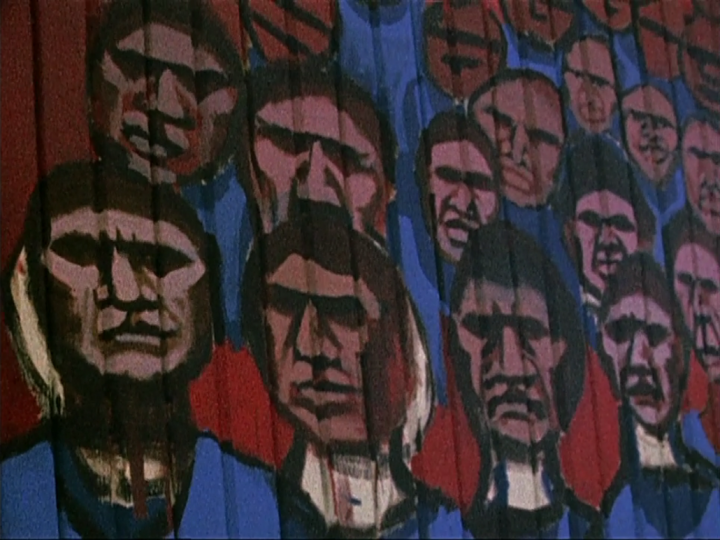
What stood out the most to you from those murals you saw in Mexico?
I guess the environment. I was in Mexico, I was experiencing what I had read about the Mexican murals. There wasn’t much written when I was younger so the little I read I would learn about when I would go to Mexico. Just the fact that I was learning what these murals meant, what they were about, who did them, and how they affected the people of Mexico, that’s what stood out the most: the environmental experience of the murals. And that’s what I learned from Siqueiros when I met him many years later, that muralism isn’t like easel painting, it’s a whole environment, it’s an experience, a whole ambiente. It’s not just a painting on a wall.
Most of the documentary revolves around a mural that you’re working on with other students on 16th and Halsted (the documentary mistakenly said 16th and Blue Island).
Yeah, most of them were high school students. I was just beginning to work with students. I had noticed that there were no murals in the neighborhood, except for Mario’s at that point and he had also worked with young people. And so the first mural I did was with students on Casa Aztlan and then I began to do other murals here and there around the neighborhood, wherever I could get permission and money for materials. This mural, the person who owned that building gave us permission. I can’t remember his name right now, he was the owner of the bar on which this wall was located and it was across [the street] from a community center that was there, and they were very helpful as well. But we had started an arts organization, myself and several other community artists, so it was a good location to do a project like this. The young folks were doing a summer youth program, and some volunteered, some were not-so volunteers, but we worked all summer on this mural. It wasn’t exactly the best quality mural, but it was a project in which the youth actually put their ideas down and we had a good experience for that summer. And the movie kinda shows what we did and how we did it.
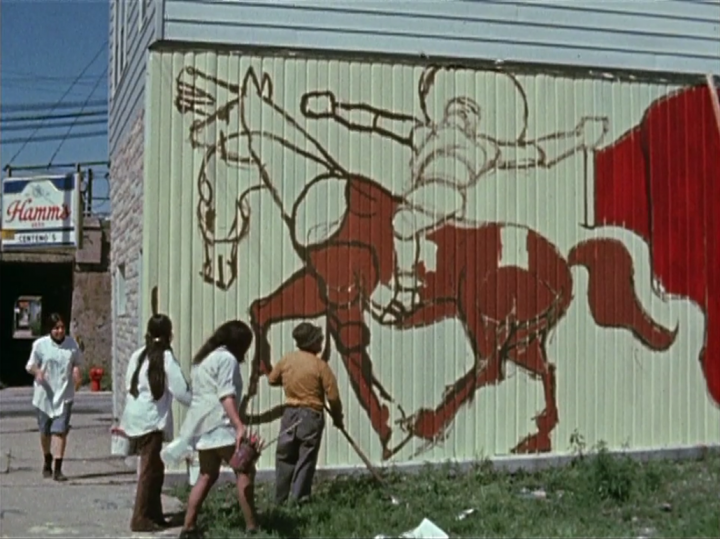
It seems to me like the muralism in Pilsen, at least in the beginning, was very community involved. You would engage the wall owners, you would engage the young people and the residents living around the artwork.
Yeah, I think the early murals everywhere in the U.S. were done that way and in some places they still are. I think they lost that momentum when grants and funding became a more important part of the process and that happens to a lot of things, not just art.
I’ve noticed in the past ten years at least that visitors and new residents seek brand sponsorships and even the support of Alderman Solis for their murals. Have things changed?
Oh yeah, sure. But that’s part of life and part of art. Things change. I mean, things changed in Mexico with the mural movement there as time went on, and at one point Rivera was espousing that workers, or rather artists, should get the same pay as regular workers. And in the meantime, while he was espousing this great prophecy (laughs) he was doing a mural for the government in the National Palace. You know he wasn’t getting worker’s pay for that. Yeah, a lot of contradictions exist in these situations and there’s almost no way to avoid it. The most we can do is to stay as close as we can to our original concepts, that’s about it.
It’s hard to keep up with the contradictions because many artists take off in their own direction. I remember one time seeing murals from San Francisco when I lived in Chicago and Chicago’s attitude, I’m sorry to say or maybe I’m glad to say, is real different than the West Coast. So when I saw the murals from San Francisco, I said, how can these people be doing this stuff? To me at that time it was all parrots and palm trees, and here [in Chicago] we are doing what I thought was more political, edgy stuff. Eventually I got a job at the University of California and moved out here and I got to know some of the artists, the mujeres muralistas whose work I was criticizing [while] living in Chicago, and I got to know the community and it was more than I thought. I was looking at it from a distance, I was criticizing something I didn’t know anything about. I was just looking at the images and not at the internal structure and what was going on here in the daily life. But after living here a few years, I caught myself doing a mural in a big restaurant here, and guess what it was? Parrots and palm trees. And it was to make some money, but also working with students to give them the experience doing large-scale artwork. It also taught me that the criticisms sometimes come back at you. They’re not just black and white, you have to look at things from a number of different angles.
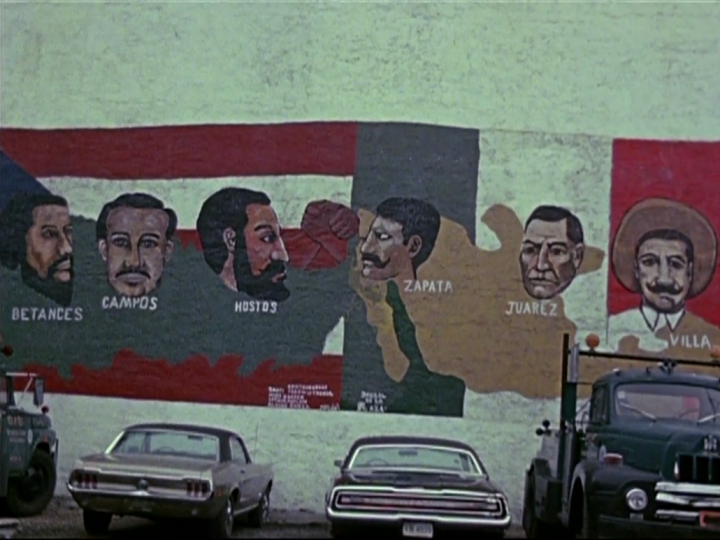
A lot of the Mexican artists here in Chicago struggle to reconcile paying the bills and spreading their political or social message. Do you have any advice for them?
I remember one time Marcos Raya, who’s doing very well in Chicago, had come to me holding his head very emotionally when he was still struggling as an artist and said, ‘Patlan I don’t know what’s going on here, I went to’–I won’t mention the name, but it was one of the bigger businesses in the community–‘and asked them if I could do a mural for them and they said yeah,’ he said, ‘but they wanted to pay me with 200-pound bags of frijoles’. And that’s a real insult for artists. Of course he didn’t do it, but he’s no longer working for frijoles (laughs). But we all go through that kind of ridiculous period. Fortunately, I never really had to but I know a lot of artists do. The only thing I can say is you have to side-step it, seek out more lucrative work, and it’s not easy especially if you’re just beginning. Your work has to improve, you have to find a way of getting it out there and making it stronger.
You were one of the first artists to take off and you moved from Chicago. Can you tell me why you made that decision?
Sure. I was criticized by my counterparts, many of the vatos in the neighborhood said, ‘Why are you leaving us man? Where you going?’ I told them, this isn’t the only place in the world, there’s a whole world out there, man, and if you don’t realize it then you have a real problem. You can’t just stay here. Well, most of those guys are no longer around, they died, they got killed for the most part or they killed themselves with dope. But I left because I was unemployed. As you said, I was having a hard time making it. The art was not doing very well for me at that time and I got a call from an old friend from Taylor Street who had lived in California for a while and he asked me what I was doing. I said, well, I’m struggling with my art, I’m making it but barely. He said, ‘Well, how’d you like to teach?’ And when he said that I thought maybe high school or something because I didn’t even have a BA. But what he was talking about was the University of California-Berkeley. I said, how am I gonna do that? He said, ‘Let me worry about that, come out for an interview.’
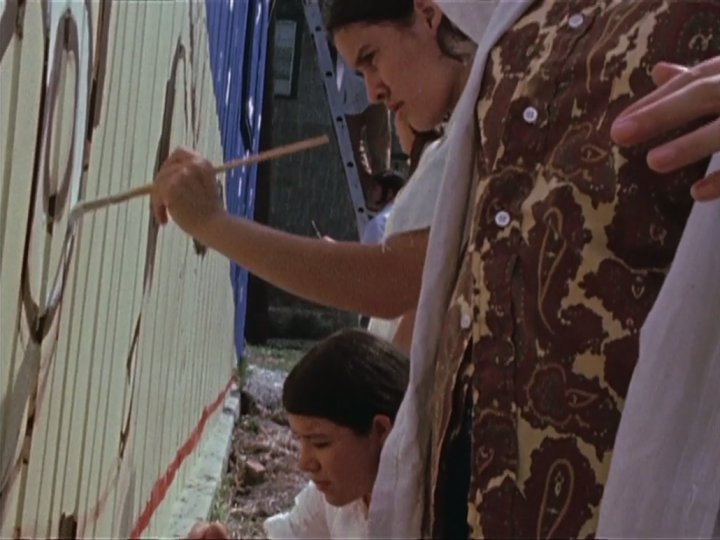
He said he had showed some of what I had done out on the street, like Viva La Causa and a number of other projects I had done. It was community work, and the Raza Studies at UC Berkeley was real interested in that kind of stuff at this time. It was kind of the peak of community organizing in the Raza Movement. So I came out for an interview and a couple of interviews later I was teaching mural art and photography at UC Berkeley. And that’s how that happened. I couldn’t say no. I mean, that was an opportunity I couldn’t reject. I took the job and it was contingent on my finishing my BA. So I went to Chicago State University and I just had a few units to finish. Victor Sorell was a good friend and he helped me get the right classes and meet the right people. I got my BA, got the job and went out to California. And when I got out here I got my MFA. That’s how it happened, it was kind of a progression.
And you’ve been in California ever since?
Yeah, since ‘75.
Let me go back to the film. What were people’s reactions, from what you remember, to the first works of public art that you or Mario or anyone else put up?
Well, because there wasn’t much of it, people thought it was nice. There wasn’t a lot of real heavy excitement. Local people thought it was nice, we got a little press here and there, there was newspaper stuff about it, I think we got a little TV coverage on the news in the evening. But the neighborhood people thought it was great because it was, of course, some color in the neighborhood finally, and then working with kids was really important for a lot of people in the neighborhood. I think the kids more than anything thought it was a good thing. The community center felt it was an important component to their program, working with the kids out in the street. Some of the gang members, which I was a part of in my early days, would come by and say, ‘Man, that’s good, what you’re doing.’ They really felt it was an important part of life in the barrio, you know, they felt like it was gonna change the neighborhood, and I was glad to feel that.
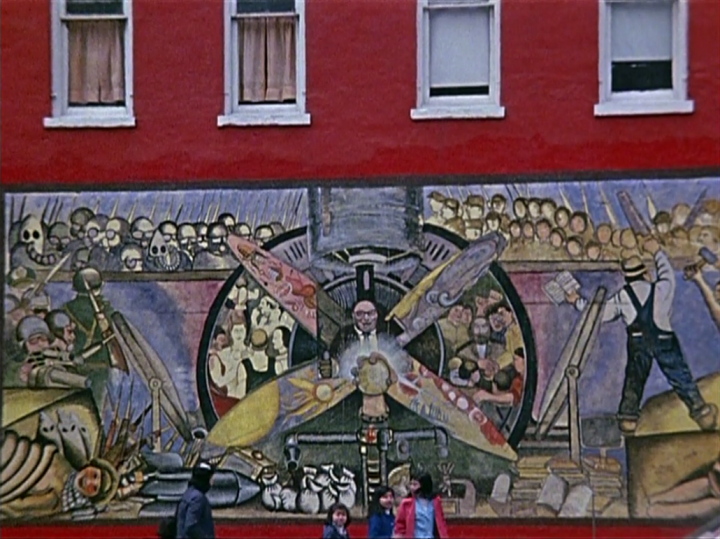
Did you say you were a gang member?
Well, I had been a gang member as a young person, a member of the Latin Counts and a member of the Morgan Deuces, and I still had some of those connections.
Gang violence in Pilsen is more or less nonexistent now (comparably), but it’s still going on really hard in neighborhoods like Little Village. Do you think art and muralism can be used to solve or alleviate it?
I think it’s a good tool to bring youth together to a different mindset, yes I do. And I think it’s something that I won’t say solved the problem in Pilsen, but it made young people work together in a different way. Like I said, I was a gang member so I watched it from the inside and the outside and not just as an observer from the distance. I don’t think it’s a solution to the problem, I do think it’s an aid, I think it helps. I think anytime you can get young people together in some kind of creative, constructive process, you’re helping move them away from the destructive.
What were some of the themes that you would try to convey in your earlier murals?
A lot of their personal ethnic history. Mexican history, give them a sense of pride about their Mexican history. But local people would bring in American history as well and kind of connect it, which was good, there was nothing wrong with it. At first I kind of thought, well, that’s kind of like mixing eggs and marbles, but it wasn’t, it worked good because the kids related to both and of course we’re both so it had to be part of the process. And the good part is that the community got involved and the kids respected the elders in the community enough to take their advice. You know how that old saying is, it takes a village? Yeah, so it was part of the village process and the art was the catalyst.
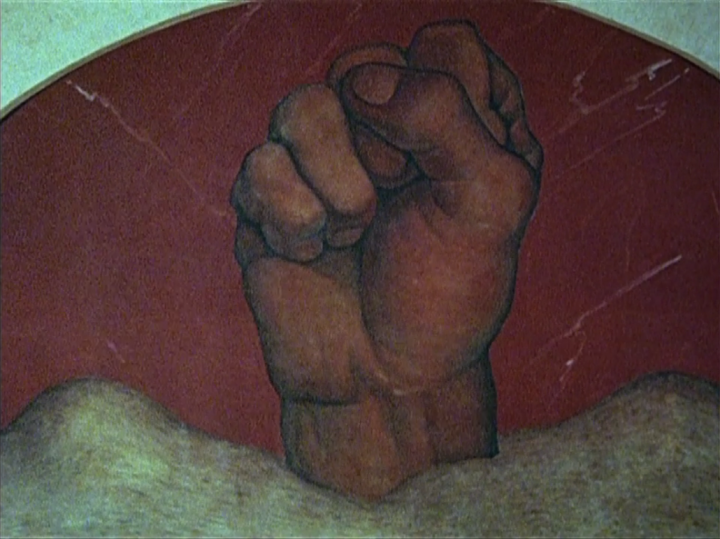
It’s safe to say that you and Mario were the first muralists in the Pilsen area, correct?
I would think so. Well, it was me, Mario and Marcos. But Marcos was working basically on his own. He eventually had some young people working with him, but mostly he worked on his own.
Do you remember who came after you?
Well, there were several people, but I don’t remember their names at the moment. Of course, there’s what is his name? The guy who’s doing the great work now. Roberto. What the hell is his last name? I got artwork here, too, of his. Valadez. And several guys who were doing great work there. But Roberto is one of the primary people. They’ve even talked about restoring some of the work I’ve done. They’ve not been able to get the money together and the time, they’re too busy making a living. But just the fact that they had the idea is enough for me.
I’ve heard about restoration ideas of old murals, and I think I agree, usually there isn’t the right person or the right funding available to make it happen.
Yeah and then you would have to keep restoring it because the weathering in Chicago is so harsh, it would take a constant restoration to keep it going. It’s really a nice thought, but at the same time I firmly believe, and this is something that I hope will go on your interview, that our murals should continue to evolve and what I mean by that is that they should change. We should not continue to restore the same murals over and over and over, no matter how great they are. We are not Riveras, we are not Da Vincis, we are not Fridas. We are community muralists and our work should change. When we paint as community muralists we’re painting about change; that’s our premise. We’re talking about making change, we’re talking about change in general, in life. And if we’re painting about change we should be willing to accept it.
I’m not an artist myself, but I feel like a lot of today’s murals do not carry a political or a social message.
Many don’t. Many are just money makers or ego boosters, but that’s a lot of what art is taught about in schools and in history.
There’s a term in psychoanalysis, creative malady, that basically says that artists are tortured and impoverished, and that’s all bullshit. Give me some money and see how creative I can be (laughs).
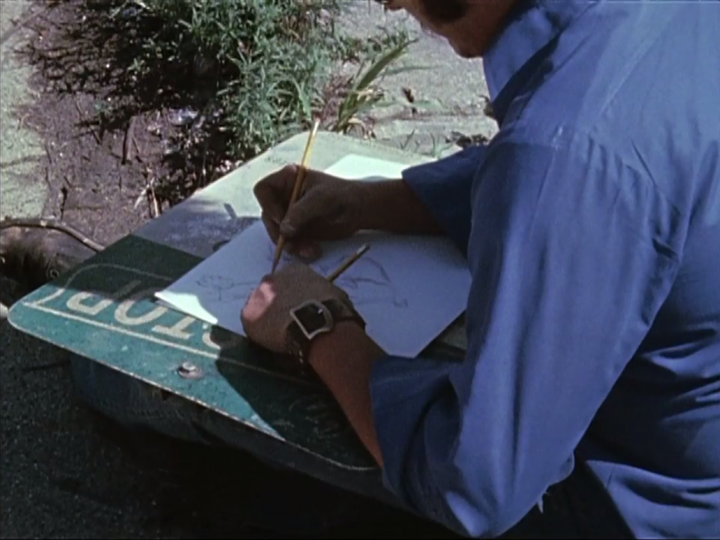
So you got to meet Siqueiros, how did that happen?
It was a long story. I went to Mexico City to meet him and it took almost two weeks to see him. They kept telling me to come to the studio tomorrow, blah blah. I didn’t realize it, but he was just becoming ill so he wasn’t frequenting the studio. I’d go back and he wouldn’t show up and I’d go back. I got to know the assistants very well. Finally, one day I went and they were all excited. They said, ‘He’s coming today for sure, he’s gonna be here’. I said yeah right, but sure enough, he showed up and I got to talk to him. He had hurt his wrist because he had fallen off a scaffolding and that’s why he hadn’t been coming in. He had a cast on his wrist. After that I got to meet him a couple more times, even when he was very very sick. He was dying of cancer. He allowed me to visit him in his studio in Cuernavaca.
It was an interesting relationship. He knew who I was, nothing too close and nothing too distant. I remember calling once from Mexico City to Cuernavaca and the assistant answered the phone. I could hear him in the background asking who it was and the assistant said, ‘It’s the young man from California,’ and I heard Siqueiros say, ‘Oh, el Chicano’ (laughs). ‘Tell him to come.’ They had been saying no because he was real sick, but he allowed me to come. And at that time I had brought two young gang members with me from 18th Street, Arturo and Dirtball. They came with me and we were at the door and they weren’t opening, it took them a long time to come to the door. So they were like typical Chicago street, making fun of me, ‘Sure Ray, you know this guy!’ It was a big house, kind of like a mansion with gates and stuff. All of a sudden, like in one of those horror movies, the gates squeak open and you should’ve seen these guys’ faces, their jaws dropped. They looked up and there’s Siqueiros standing there and they were speechless. Because they had seen him in pictures and books I had shown them, they had seen his work, they knew who he was, and they were in awe. I mean, I couldn’t get a word out of them, they didn’t know what to say. It was like they had seen Jesus or something. It was unbelievable, the respect. So it was like I introduced 18th Street to Siqueiros, too, not just myself.
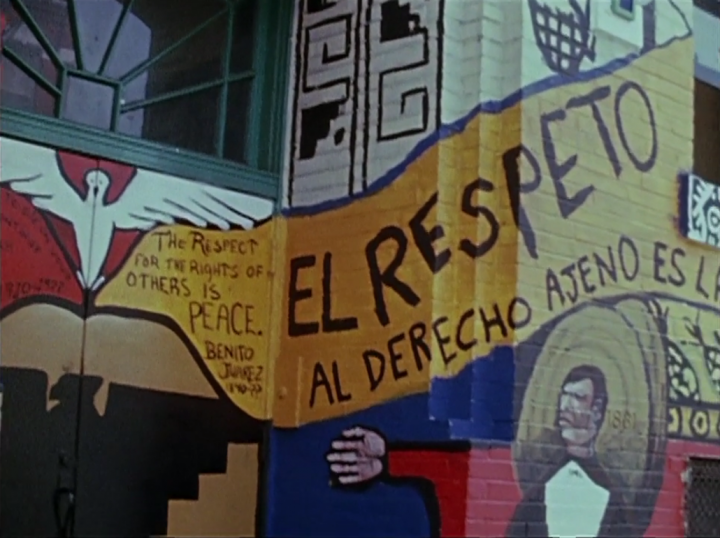
That’s impressive and worth mentioning for sure. Let me go to the title of the documentary, Viva La Causa. Was it chosen by the filmmaker?
Well, that was the title of the mural. That’s what we chose as the title of the mural so that became the title of the documentary.
When you say La Causa, what do you mean?
The movement of Raza up to that period. Cesar Chavez and Dolores Huerta and what was going on in the neighborhood with education, the attempt to get Benito Juarez high school which we fought for for years. The struggles that were going on.
There’s also a song that plays in the film that goes something like, “Yo soy Chicano de la dieciocho…”
Funny. It’s not a Raza song necessarily. I’ve never said this before, but it’s actually an old Italian communist song from the Italian movement back in the ‘30s. It’s from a movie that I saw and the kids liked the beat of it and the tone so we used it. It was also used in another Raza movie, but I can’t remember which. It’s not a new song, but the lyrics we changed slightly, of course, to suit the film and the time.
I know some of your earlier work was out of Casa Aztlan, and as you know, Casa Aztlan is no more. It’s just sitting there. People reminisce and remember but it’s no longer active. What are your thoughts?
I’m sorry to hear about it and I wish something could be done about the murals, but I don’t think there’s enough money to do that. It would be too costly to save the murals that are in there right now. Casa Aztlan was created to change from a totally German-Bohemian settlement house, which was one of the old Jane Addams homes, to suit the current population which became Raza. The Brown Berets began to have activities there, the folklorico began to do dances there, arts and crafts, photography, and other Raza activities.
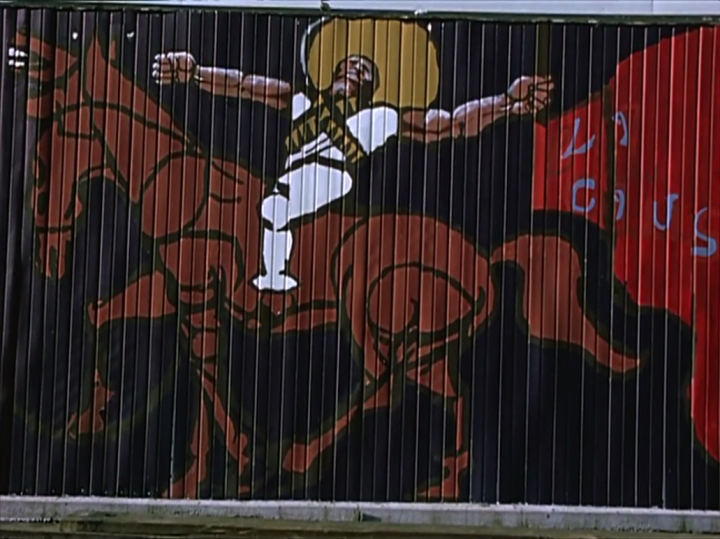
You’ve been living in California for a long time, and I’m sure you’re familiar with the once-predominantly Mexican ‘Mission District’ and how it’s been gentrified. People argue that across time the same thing is going to happen to Pilsen and some of these Latino neighborhoods that are closer to the North Side. What do you think will happen to the art by the Mexican community?
Well, it’s already happening. In the few visits I’ve made in the last few years to Chicago, I see it happening and of course it’s going to happen. It’s money. It’s all about money. I remember when I first came here [to California], I had a number of Chicano architecture students who wanted to learn about murals because they wanted to incorporate art in their buildings. They’re still good friends, they’re now professional architects, big time. But they told me in 1975 like fortune tellers, ‘You know what, Ray, you’re not gonna believe this but in 20 years the Mission District, and San Francisco in general, is gonna be a Disneyland for the rich.’
Oh man.
And there you go. They saw it way back then. They could tell just from looking at city plans and what was going on with the architecture. The young people see that stuff way ahead of time.
You’re not an expert on gentrification or resistance against gentrification, but do you have any advice for young people who are just trying to survive in their neighborhoods?
No, I don’t because I see it happening to me. I’ve already been moved once from San Francisco because of gentrification. I had a great life of almost 30 years in San Francisco and I had to move. I don’t mind it because I have a good place in Oakland, but I had to move because of the cost of living. Money is evil sometimes and there’s no way to convince people that have it of that fact, they’re too caught up in their own ways.

I don’t know if you noticed what happened to the Mexican- and Chicano-inspired murals in some of these gentrifying neighborhoods. Do you know if they get taken down or painted over?
I don’t want to make you sadder, but yes, they become very much… what do you call it when you go to a hospital and everything is totally clean?
Sterile.
Yep, that’s the word. They still have murals but they’re totally sterile. They become goofy, in my words. They’re well-done, they’re clean, and they get lots of money to do them. Not like our murals, the ones we’re talking about that we struggled to get funding for. But the artists are pulling together, not just Raza artists but across cultures, to keep the mural thing going [in San Francisco]. What we’ve done is created small pockets of mural environments like alleyways and stuff. But it’s not going to stay forever, we know that, but we’re doing the best we can. Like I initiated a project about 1984 which was to talk peace about Central America, and we organized 25 murals (and about the same number of muralists) to do murals in nine months. And I raised funds and Patricia Rodriguez, one of the muralistas, talked to the neighbors about doing the murals on their property. And we got it done, we did this whole alley and it’s become pretty famous actually. We brought out 2,500 people [for the unveiling of “Balmy Alley”].
I’ve been there.
Yeah. Those kind of projects really help to solidify the murals in the community. But again, they’re not going to stay forever. Eventually, the artists we’re talking about begin to creep in.
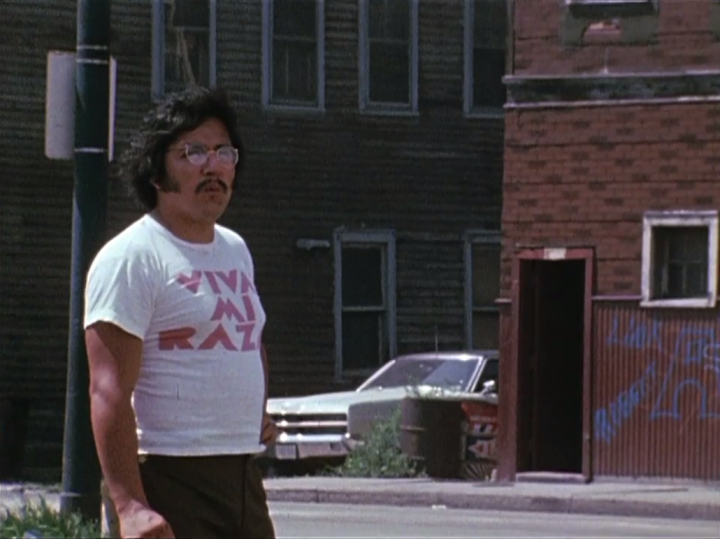
Interview by Jackie Serrato
Images courtesy of Kartemquin Films
@HechaEnChicago